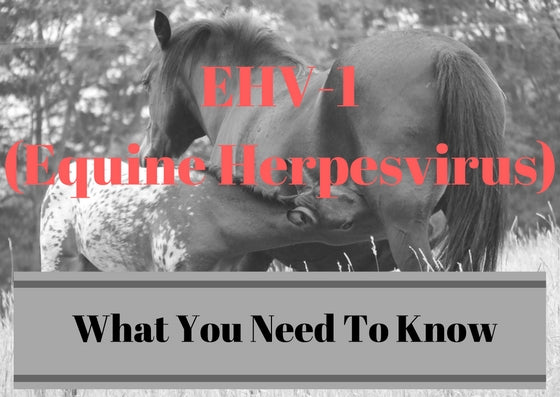EHV-1 is one of the most contagious of infectious equine diseases. Knowing how it spreads and what to watch for are two of the critical elements in helping prevent an outbreak among your herd.
Jump to Key Section
Overview of EHVThe science of EHV, equine herpesvirus, strains is reasonably complex. These strains consist of “enveloped double-stranded DNA viruses.” There are five equine herpesvirus strains, with EHV-1 and EHV-4 being the most damaging. Almost all horses around the world have some form of this infection. The majority of infected horses do not develop severe symptoms, but some go on to suffer from the most severe form, EHV-1. What Is EHV-1?All forms of EHV are common in the Americas and abroad. The nature of this disease allows it to spread quite readily, making it possible for large EHV-1 outbreaks to occur with exposure originating from only one carrier. The incubation time for EHV-1 can last anywhere from two to 10 days, meaning a horse can have the disease and not show symptoms for more than a week. Of the most common forms of equine herpesvirus, EHV-1 has the potential for causing the most severe symptoms, including abortions, death of newborn foals, neurological disorders and respiratory problems. 2. How Is EHV-1 Different From EHV-4?People still sometimes call EHV-1 the “equine abortion virus,” as it can cause spontaneous abortion of in-utero foals. EHV-4, on the other hand, tends to show up in foals and yearlings as a respiratory illness often referred to as “equine rhinopneumonitis virus.” It’s crucial to note that EHV-1 can present with respiratory signs and EHV-4 can also cause abortion. Both of these strains have also been known to cause neurological disease. Because EHV-1 is more prominent and tends to be more devastating, it will be the focus of this article. 3. How Common Is EHV-1 in Horses?Though it can become severe, EHV-1 infects most horses. The majority of horses have exposure to this disease in their youth and never develop symptoms. Unfortunately, you cannot know if your horse will develop the more severe neurological signs of this condition. Looking out for early symptoms of this disease will help you get your horse the treatment it needs. 4. What Causes Equine Herpesvirus?The origins of EHV in horses start in foals. These young horses typically get exposed to the virus from their mothers. At age 2, almost all horses have a latent form of the virus. Symptoms do not occur until times of stress reactivate the virus in the body. These stressful incidents include weaning, long transport and excessive or strenuous exercise. If the neurological form of the disease manifests, the horse may show some of the more severe symptoms of EHV-1. What Are the Symptoms of EHV-1?EHV-1 can cause respiratory, reproductive and neurological disease in adult horses, yearlings and foals. Some symptoms are easier to detect than others, making it difficult to diagnose in some cases. After the virus reactivates in the body, symptoms could appear as soon as 24 hours or within four to six days. 1. What Are Respiratory Symptoms of EHV?Horses suffering from respiratory EHV-1 will display several different symptoms. They can be mild to severe. Fever tends to precede any neurological symptoms. The temperature has an unusual pattern, spiking at onset during the first day or two, dropping, then rising again at day five or six of infection. Because these respiratory and neurological signs can also indicate other illnesses, horses with these symptoms need a vet to test them via blood and nasal swabs to check for EHV-1. Signs and symptoms of respiratory EHV-1 include:
If these respiratory signs or a fever affect a horse with exposure to another animal with equine herpesvirus myeloencephalopathy, EHM, which is another name for the neurological effects of EHV, take the horse to the vet for diagnosis. 2. What Are the Signs of EHV-1 Showing Neurological Effects?In many horses that develop EHM, the respiratory symptoms remain mild or absent, with a rectal fever of over 101.5 degrees Fahrenheit as the only sign of problems developing. Neurological symptoms appear quickly and with little warning aside from the fever. The intensity of neurological symptoms reaches its worst within the first 24 to 48 hours after their onset. Horses with the neurological form of EHV-1 will display a handful of symptoms that can include:
3. Does EHV-1 Cause Abortion in Horses?Unfortunately, there are no apparent signs that a mare is going to abort a pregnancy due to the EHV-1 virus. It can happen in conjunction with respiratory or neurological EHV-1, or without any outward signs that something is amiss. How Is EHV-1 Diagnosed?If a veterinarian suspects EHV-1, depending on the state they are practicing in, they may or may not be required to report their suspicion of infection to the state’s veterinary governing body. Regardless of reporting requirements, a veterinarian should test for the virus to aid in treatment and help prevent a widespread outbreak. Testing for EHV-1Subjective and objective observation and examination of a horse displaying symptoms will allow a veterinarian to determine a suspected EHV-1 diagnosis. A doctor can test for EHV-1 via a nose/throat swab from the sick horse and any horses that may share common areas or facilities with it. Other means of testing can include tissue samples from an aborted fetus or blood tests from the diseased horse. These may also include paired blood samples that will allow for the detection of antibody levels. It is essential to note that asymptomatic horses can still be carriers and shed the virus. If a vet suspects a symptomatic horse has EHV-1, they may recommend testing all horses that may have come into contact with that horse, or shared common areas. Horses that have recovered from EHV-1 can still be carriers; the virus can be latent for years but re-triggered when the horse is stressed or otherwise immunocompromised. What Treatment Options Are Available for EHV-1?Because EHV-1 is a virus, supportive care is essential. Antibiotics will not be effective against the virus; most horses do not experience secondary infections as a result of EHV-1, which would negate the need for antibiotic therapy altogether. Horses that are experiencing symptoms of EHV-1 may benefit from the use of non-steroidal anti-inflammatory drugs to lessen inflammation and pain while helping reduce fever. Nutritional support may also help for horses displaying loss of appetite. According to the American Association of Equine Practitioners, both active and inactive EHV-1 vaccines exist. However, no current vaccines prevent the neurologic form of the illness. In the case of horses with neurological symptoms, it is essential to try and keep them from lying down for prolonged periods. If a lack of coordination/balance is an issue, keeping them in a well-padded space, such as a stall with thick shavings, can help prevent injury. Recovery for uncomplicated cases may take place in as little as a few weeks, whereas more complicated or compromised horses have prolonged recovery time and a higher rate of mortality. Horses that are suffering from the neurological form and are unable to stand have a much poorer prognosis than those that can stand and move around. What Happens When EHV-1 Goes Untreated?Left unchecked, EHV-1 can quickly spread among horses in a stable, especially if you do not isolate the sick horse as soon as possible. Shared feed, tack, bodily fluids and even the air can carry this virus. Isolation can keep your other horses from getting it. Without supportive treatment that includes fluids, anti-inflammatories and slings, horses may have a worse prognosis than those who do receive care. This disease can be fatal in up to 50% of the horses that contract the neurological form of EHV-1, which is why prompt diagnosis and care are so vital to the horse’s comfort and survival. How Is EHV-1 Transmitted?The highly contagious nature of EHV-1 makes it difficult to control in crowded or regularly frequented facilities. The most common means of transmission from one horse to another include:
How to Prevent EHV-1 in HorsesThere is no absolute way to completely prevent exposure or infection from EHV-1. There are, however, methods that can significantly reduce the possibility of horses getting exposed to or contracting the disease from infected animals.
EHV-1 is highly infectious, but with careful handling practices, you can avoid it. EHV-1 Prevention Tips Among Healthy AnimalsPreventing EHV-1 requires taking some precautions, especially when your horses have exposure to other potential carriers. But don’t think because your horses have never been around symptomatic animals that they are safe. Even if you have healthy horses, remember almost all animals can harbor the virus in their bodies, waiting for activation. Taking care to keep your healthy horses in that state can prevent the development of EHM. Here are some things you can do to maintain the health of your asymptomatic horses:
Frequently Asked Questions About EHV-1You may have some questions still about EHM/EHV-1. Here are some of the most commonly asked questions with their answers about this condition. Always discuss specific questions about treating EHV-1 in horses with your veterinarian. 1. What Should I Do If My Horse Has EHV-1?If your horse has EHM or EHV-1, your vet may report the illness to the state. Many states require vets to inform them about horses they treat with this disease. You should receive full support from both your regular vet and the state vet. The first step in what to do if your horse has EHV-1 is to isolate the infected horse and any equipment and feed used for it. Keep visitors to only those approved to care for the horse to prevent cross-contamination with your other animals. Be prepared for a long quarantine. These isolation periods may last up to 28 days after the fever subsides. During this time, the vet may provide supportive care or antivirals, depending on the animal. Vaccines will not prevent EHM in other horses in the herd. Isolation will work best to keep your other animals from getting sick. 2. Is EHV-1 Fatal for Horses?In those cases where horses have the neurological complications of EHV-1, fatality rates range from 30% to 50%. If the sick horse remains standing throughout the majority of the illness, it has a better chance of full recovery than those that lie down. Recovery can take up to a year in some cases, but some horses get better in a few days. Such a variance in recovery times further alludes to the unpredictable nature of this ailment. 3. Can I Travel With My Horse?Discuss travel requirements or restrictions for horses in your area with the state veterinarian office. Outbreaks may limit travel. If your horse is actively sick, keep it at the farm and isolated from other animals. If your horse does not have symptoms, follow general protocols for preventing infection. 4. How Long Does the Virus Survive Outside the Body?Because EHV-1 can spread through contact with surfaces harboring the virus, you must know how long the germ stays viable on surfaces. Surfaces can keep the virus alive up to seven days in normal conditions and up to a month in ideal settings. Luckily, most disinfectants readily kill this virus. Wash off all surfaces with soap and water first before treating with disinfectant. Doing so will increase the effectiveness of the disinfectants, helping keep your other horses healthy. Reduce Stress in Your Horses and Keep Them HealthyBecause stress can reactivate equine herpesvirus in the body, reducing the stress your horses encounter can help them stay healthy and avoid this illness. Zesterra® gives your horse a natural means of support during stressful times. By improving the pH of the digestive system, horses can better use the nutrients in their feed, helping them get the fuel needed to make it through stressful periods. Feel free to contact us with any questions or to learn more about our all-natural products to support your horse’s health. For information on current outbreaks of infectious equine diseases including EHV-1, check out http://www.equinediseasecc.org/outbreaks.aspx . This comprehensive listing shares all outbreaks and status, in addition to the origin of disease, if known. Related Posts The Mare: Pregnancy Trimesters 1-3 The Mare: Pre-Breeding Considerations Foal Diarrhea 101: Signs and Symptoms Sources:
Updated: 08/19/2019 3:21pm |





